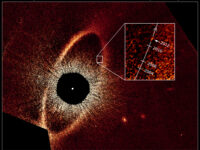In 1980, astronomer Carl Sagan stated, “We’re made of star stuff.” Around 13.8 billion years ago, the Big Bang occurred and created the “star stuff” that forms the universe we know today. However, that explosion created more than just matter; it created antimatter too. Always produced as a pair, antimatter and matter are very similar. However, some of their characteristics are flipped, such as electric charge. All particles of matter have an antimatter equivalent. For example, the antiparticle to a negatively charged electron is a positively charged positron. Same mass, different charge. Neutrally charged particles, such as neutrons or photons, are their own antiparticles.
That explosion created more than just matter; it created antimatter too.
If the two forms of matter are always produced as a pair, it seems the universe should have the same amount of matter and antimatter. Yet, this is impossible. When matter and antimatter meet, they destroy each other and release energy in the form of light or heat. If there were equal amounts of matter and antimatter in the universe, constant bursts of energy would be released. Masses of matter, such as our sun or the earth, would never be able to form as they would constantly be in contact with antimatter and quickly destroyed. The observable universe is made up of almost entirely matter. Ergo, antimatter is disappearing.
So where did all the antimatter go? Many scientists have conducted experiments to investigate antimatter’s disappearance. One theory was that antimatter reacts differently to gravity than matter does. If true, this theory violates Albert Einstein’s weak equivalence principle which states that free-falling particles have the same laws of motion as particles observed from a position moving at an unchanging speed. While conducting a somewhat unrelated experiment to determine the charge-to-mass ratios of protons and antiprotons, the RIKEN-led Baryon Antibaryon Symmetry Experiment (BASE) collaboration at CERN determined that, under the strict initial boundary conditions set by the experiment, matter and antimatter respond identically to gravity.
Over the course of 18 months, these experts studied antiprotons and negatively charged hydrogen atoms. The negatively charged hydrogen atoms served as a substitute for protons. The team used CERN’s Penning trap, a device commonly used for storing charged particles such as antimatter. The trap consists of a magnetic field with electric trapping plates. This creates a magnetic field that is orthogonal to an oscillating electric field. The particles are excited by the oscillating electric field to a harmonic frequency and the combination of the fields causes them to move in a cyclical trajectory. The antiprotons and negatively charged hydrogen are placed one by one into the trap. The trap applies identical conditions to the particles so that their cyclotron frequencies, or the frequency at which a charged particle moves perpendicular to a magnetic field, can be measured. The cyclotron frequency is based on a circular path and depends on the strength of the trap’s magnetic field and the charge-to-mass ratio of the particle. With this method, scientists determined the particles’ precise charge-to-mass ratios. Their results matched the existing Standard Model of relativistic quantum field theory, which describes three of the fundamental interactions between particles (electromagnetic, strong, and weak). Interestingly, the Standard Model omits gravitational interactions between particles.
The gravitational accelerations of the particles were 97 percent identical.
The team then investigated the gravity-based weak equivalence principle. By accounting for the fact that the experiment was conducted on Earth and that the measurement was made in Earth’s gravitational field, the scientists determined how matter and antimatter respond to gravity. The gravitational accelerations of the particles were 97 percent identical.
Other research groups currently planning to conduct similar experiments hope to produce results with the same 3 percent inaccuracy. Should there be a greater error, perhaps that is the answer as to why antimatter is so scarce. Regardless, the answer to this question is not simply knowledge for knowledge’s sake. Inspired by the Starship Enterprise from “Star Trek,” NASA is already exploring the possibility of creating antimatter spaceships to reach Mars and other star systems. From nuclear weapons to space exploration, the discovery and development of antimatter can lead to new breakthroughs in the energy we use.
Nature (2022). DOI: 10.1038/s41586-021-04203-w
Comprehensive Analytical Chemistry (2015). DOI: 10.1016/B978-0-444-63340-8.00002-9

